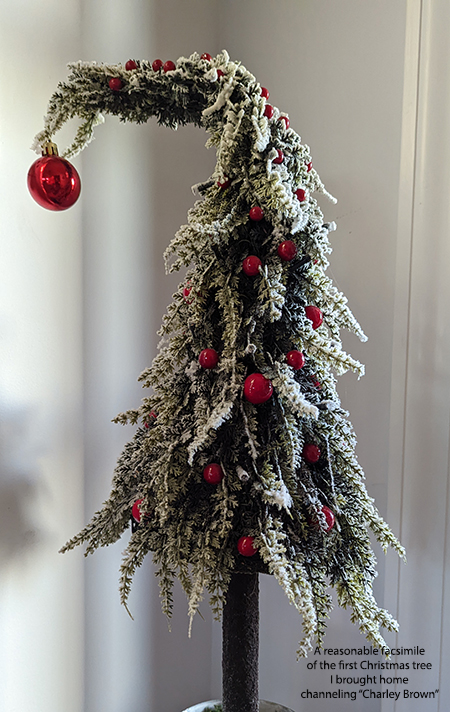With Christmas comes a perennial rush to decorate a tree in your home. As a Christmas tree neophyte in the early days of my marriage, it became rapidly apparent that I was not to be trusted with such a purchase on my own. Over the years, we went through a succession of cut trees, trees with root balls, and for several years, an artificial tree whose height matched the vaulted ceilings of our common room. For the few years that I lived in Manhattan, the annual Christmas tree purchase was accompanied by taking out a small loan to cover the purchase.
 Christmas trees are filled with meaning
Christmas trees are filled with meaning
Evergreens have a special meaning for those locked in cold climes as winter arrives, if for no other reason than as a hopeful sign of spring. The French in the Alsace have been credited with popularizing placing a small cut tree in your home for Christmas back in the early 1500s. The trend spread quickly to their neighbors, the Germans, models of industrial efficiency who made Christmas trees a “thing.” However, keeping with their Lutheran heritage, they remained undecorated for some time. (Except for a candle, symbolic of the guiding star) What we might consider the modern-day Christmas tree was the result of the most significant influencer of the 1800s, if not all time, Queen Victoria. She and her husband, Prince Albert, loved tinsel and decoration, sleighs and reindeer; perhaps, along with that novel by Dickens, A Christmas Carol, they created the contemporary Christmas and Christmas tree.
Today, the acquisition of a Christmas tree, natural or artificial, may also serve to signal your feelings about sustainability.
Christmas tree’s carbon footprint
As with calculating the carbon footprint of anything, there are many variables to consider between real and artificial. According to the British Carbon Trust, a group working to rapidly decarbonize our world, a natural tree has a far smaller carbon footprint than an artificial tree. And while that is generally true for a one-and-done Christmas tree, many variables result in many caveats
Natural trees absorb carbon while they grow, including for the short time they live in your home. All in all, a natural tree takes in 18 kg of carbon over its ten-year growth period. Now, this environmental benefit is exceedingly tiny; when it comes to trees absorbing carbon, forests do the heavy lifting, and Christmas trees are no longer cut down from forests; 98% come from tree farms. Few of us live next to a Christmas tree farm, meaning the trees must be transported. If you are like the folks around me, coming out to the Christmas tree farm is a holiday event – a 20-mile round trip in the car for the tree puts those 18 kgs of carbon back into the atmosphere, negating all those years of absorption.
There is also the problem of managing the tree after its vacation in your home. Trees with a root ball can be replanted, assuming you have provided it with sufficient water and a large enough root ball (A five-foot tree needs a 2-foot root ball). Cut trees can suffer one of two alternative fates. They may become mulch, which means the Christmas tree has a 3.5 kg carbon footprint. Or they may just be tossed into the landfill, where they will decompose, creating methane and increasing their footprint to 16 kg.
Artificial trees have a much higher carbon footprint. First, 90% of them are manufactured in China, so significant shipping and carbon are involved. Second, those trees are made from metal and plastic, with their own carbon costs from creating the materials themselves. Overall an artificial tree has roughly a 40 kg footprint. Now, all is not lost. Artificial trees can be used for multiple years. The math suggests that you must use an artificial tree for 12 years before it is equally sustainable. Parenthetically the cost of one of those trees is about $2,000, and I can get a real tree for $125, so to be financially sustainable, I need 16 years of use.
Natural trees signal you “care,” especially on an annual basis. For those long-termers, you can argue that your artificial tree is at worse, overall neutral, and at best, after 12 years or so, a carbon sink. Of course, Christmas trees have an available carbon offset; for $32, you can assuage your conscience and pay for your sins.




